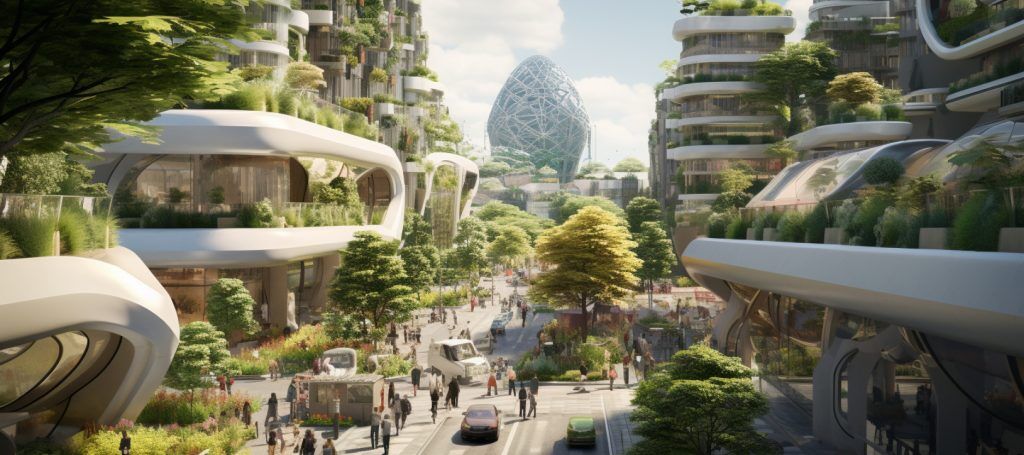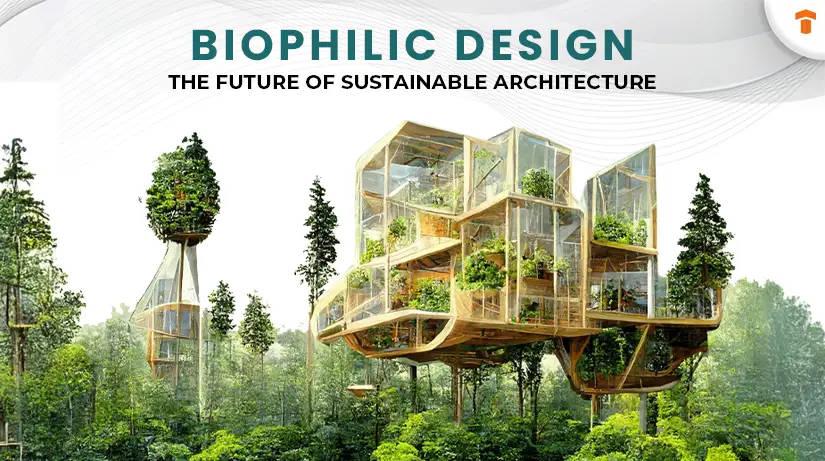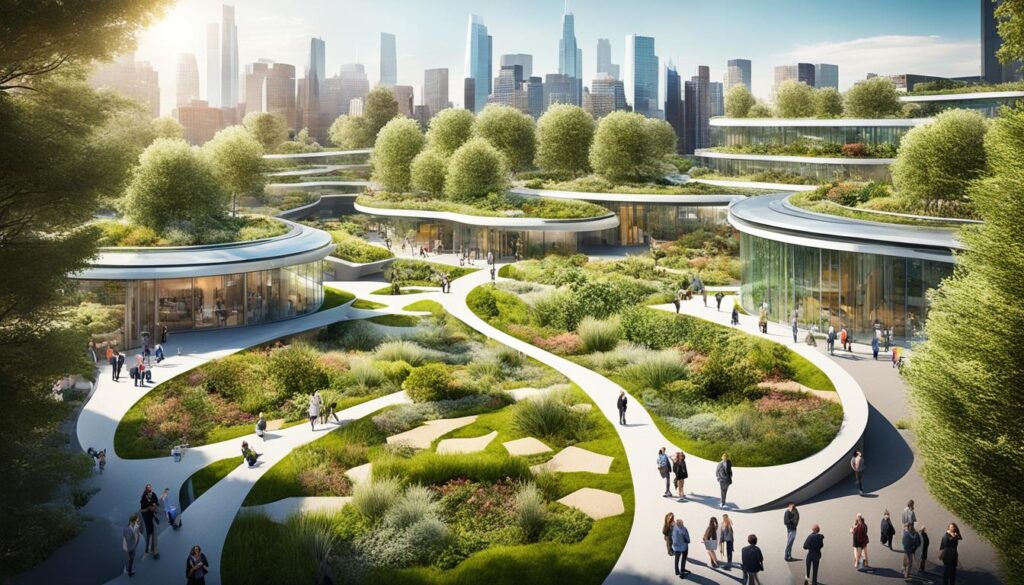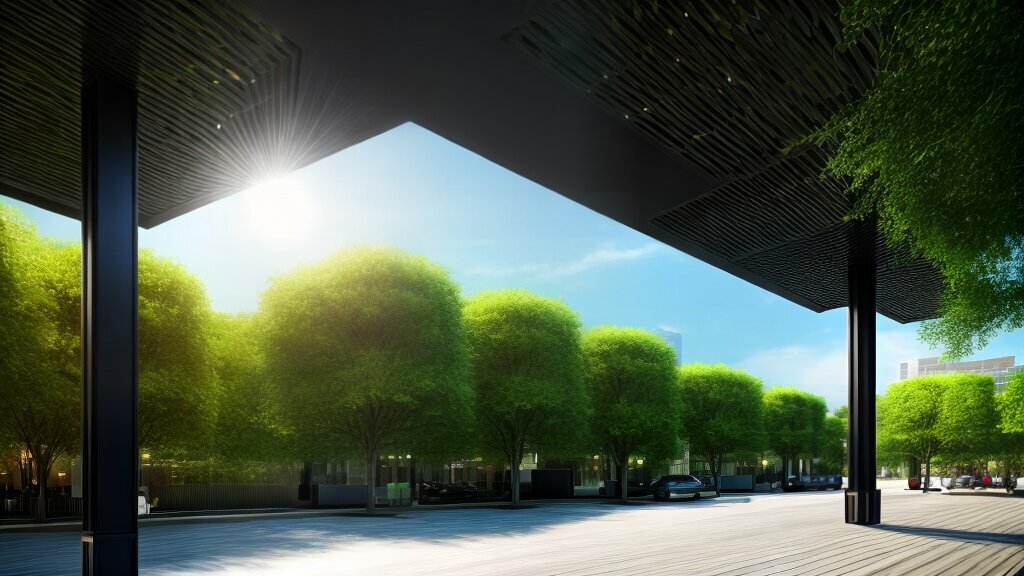The Impact of Biophilic Design on Urban Heat Islands.
Urban environments are often characterized by heat, concrete, and air pollution, leading to the phenomenon known as Urban Heat Islands (UHIs). The urban morphology and infrastructure contribute significantly to this effect. As cities continue to expand, the management of these heat islands becomes increasingly important for public health, urban resilience, and environmental sustainability.
Biophilic design seeks to incorporate natural elements, such as vegetation cover and water features, into urban planning and development. This article examines the principles of biophilic design and its potential to mitigate the effects of urban heat. It will demonstrate how this approach can enhance urban green spaces, improve air quality, promote biodiversity, and contribute to the development of healthier, more vibrant, and sustainable cities.
What Is Biophilic Design and Its Ecological Benefits?
.jpg_00.jpeg)
Biophilic design represents a progressive methodology in architecture and urban planning that aims to establish a connection between individuals and nature by incorporating natural elements into built environments. This method supports environmental psychology principles, which focus on the psychological benefits and human well-being associated with exposure to nature.
This concept underscores the significance of designing spaces that promote human well-being and elevate the aesthetic quality of urban landscapes, utilizing elements such as vegetation, water features, natural light, and sustainable landscaping.
By emphasizing sustainable design principles and nature-based solutions, biophilic design contributes to the creation of healthy, vibrant communities while addressing critical environmental challenges, including urban heat islands, climate change, and the ecological footprint of city infrastructure.
What Are the Principles of Biophilic Design?
The principles of biophilic design emphasize the enhancement of the connection between humans and nature by incorporating various natural elements, such as landscape design and ecological benefits, into built environments. These principles focus on fostering sensory experiences, improving air quality, and promoting psychological well-being through the intentional use of light, vegetation, water features, and passive cooling strategies.
By understanding the impact of nature on human behavior and environmental psychology, architects and urban planners can create spaces that not only possess aesthetic appeal but also contribute to public health, social cohesion, and community engagement.
Plus this foundational connection, biophilic design places significant emphasis on natural ventilation, which facilitates improved airflow and enhances thermal comfort within indoor environments, aligning with urban heat mitigation strategies. By integrating sensory engagement through textures, sounds, and scents derived from nature, the overall experience can become more immersive and enriching.
Furthermore, the adoption of urban design strategies that incorporate habitat restoration and urban biodiversity strategies can lead to the development of sustainable ecosystems, fostering biodiversity while also addressing concerns related to energy efficiency and climate change adaptation. This holistic approach benefits individual well-being and strengthens community ties, ultimately promoting a healthier urban environment.
What Are Urban Heat Islands?
Urban heat islands (UHIs) refer to metropolitan areas that exhibit markedly higher temperatures compared to their rural counterparts, primarily as a result of human activities and infrastructure, including buildings and roadways.
This phenomenon arises because urban surfaces, such as asphalt and concrete, absorb and retain heat, resulting in increased energy consumption, diminished thermal comfort for residents, and challenges in urban heat management.
A comprehensive understanding of urban heat islands is essential for the development of effective climate adaptation strategies and for enhancing urban resilience in the face of increasing temperatures and the challenges posed by climate change.
What Causes Urban Heat Islands?
The causes of urban heat islands (UHI) can be attributed to several factors, including the prevalence of heat-absorbing materials in urban environments, limited vegetation, and specific land-use patterns. Urban areas typically consist of surfaces that absorb significant amounts of solar radiation, resulting in heat retention and elevated temperatures.
The scarcity of green spaces and tree cover exacerbates this issue by diminishing shade and cooling effects. Understanding these causes is essential for the formulation of effective urban planning strategies aimed at mitigating the impacts of UHI, improving livability, and implementing sustainable urban heat management practices.
Integrating urban forestry initiatives and green architecture into community designs can significantly address the challenges posed by urban heat islands. By strategically planting trees and creating parks, cities can enhance shade and promote natural cooling.
Sustainable land use planning, which emphasizes the incorporation of green roofs and permeable surfaces, is crucial in lowering surface temperatures.
As communities seek resilience against climate change, the adoption of these green strategies not only helps alleviate heat stress but also fosters healthier and more vibrant living environments for residents through sustainable development and nature integration.
How Does Biophilic Design Impact Urban Heat Islands?
Biophilic design is instrumental in mitigating the effects of urban heat islands by increasing the presence of natural elements within urban environments.
The incorporation of features such as green roofs, living walls, and urban vegetation can significantly reduce heat absorption, promote cooling effects, and contribute to nature-based solutions. Additionally, these design strategies contribute to improved thermal performance, urban biodiversity, and public health, offering ecological and psychological benefits.
Consequently, biophilic design offers a comprehensive approach to urban sustainability and climate adaptation, facilitating habitat conservation and energy conservation.
1. Increases Green Spaces
Increasing green spaces through biophilic design is essential for mitigating the effects of urban heat islands, as these spaces provide shade, absorb solar radiation, and support carbon footprint reduction efforts. Green areas, such as parks and community gardens, not only enhance the urban landscape but also contribute to biodiversity and improve air quality.
By integrating green spaces into urban planning, cities can promote social interaction, recreational opportunities, and overall community well-being.
The presence of greenery fosters a vital connection between residents and nature, which is important for psychological health and nature therapy. Urban biodiversity flourishes when native plant species and habitats are preserved or created, providing refuge for various fauna and enriching the local ecosystem.
Thoughtful design in the creation of parks and natural habitats encourages individuals to develop deeper relationships with their environment while simultaneously fostering a sense of belonging. Incorporating natural features into cityscapes not only enhances aesthetic appeal, social equity, and cultural connections but also promotes active lifestyles, ultimately leading to healthier and more socially cohesive communities.
2. Reduces Heat Absorption
.jpg_01.jpeg)
One of the primary advantages of biophilic design is its capacity to reduce heat absorption in urban settings, thereby significantly enhancing thermal performance and energy efficiency.
By employing reflective materials, implementing green roofs, utilizing strategic landscaping, and eco-friendly materials, buildings can effectively maintain cooler interior temperatures and decrease energy consumption, contributing to energy efficiency. This reduction in heat absorption not only improves the comfort of occupants but also serves to mitigate the urban heat island effect.
Furthermore, the integration of features such as shaded walkways and water elements, including fountains or ponds, can further cool the surrounding air and create microclimates that promote thermal comfort and urban heat mitigation.
By utilizing eco-friendly materials with insulating properties, buildings can diminish their reliance on mechanical cooling systems.
In this manner, the strategies employed in biophilic design not only align with the objectives of sustainable urbanism but also advance climate-responsive design that addresses the urgent necessity for environmental resilience and urban sustainability practices.
Such intentional design approaches ultimately contribute to the creation of healthier living environments, urban ecosystems, and landscapes while tackling the increasingly critical challenge of climate change.
3. Improves Air Quality
Biophilic design significantly enhances air quality in urban environments, primarily through the integration of urban vegetation, green infrastructure, and sustainable cities initiatives. Plants possess the natural ability to filter pollutants and produce oxygen, resulting in a healthier environment for residents.
By adopting biophilic design strategies, cities can effectively address issues such as urban heat islands while simultaneously promoting public health and well-being, thereby enhancing the overall quality of life.
Plus improving the aesthetic appeal of urban spaces, the incorporation of greenery serves as a natural air purifier, capturing dust and particulate matter while contributing to a more sustainable urban ecosystem.
Water management systems, including rain gardens and green roofs, are also instrumental in mitigating runoff, improving water quality, and supporting stormwater management in surrounding areas. These initiatives foster community engagement and social interaction, encouraging a sense of ownership among residents.
As the presence of green spaces continues to increase, the positive environmental impact compounds, ultimately resulting in healthier neighborhoods, reduced stress levels, and greater community health, which are positively associated with improved mental health outcomes.
What Are the Benefits of Biophilic Design in Reducing Urban Heat Islands?
The advantages of biophilic design in mitigating urban heat islands are extensive, encompassing ecological, social, and economic benefits, including reduced ecological footprints and enhanced urban aesthetics.
By incorporating natural elements into urban settings, biophilic design not only alleviates the impacts of climate change but also promotes human well-being through enhancements in mental health and community cohesion.
These benefits significantly contribute to the resilience of urban areas, rendering them more adaptable to future challenges.
1. Mitigates Climate Change Through Urban Heat Management
Biophilic design is a significant strategy in addressing climate change by fostering sustainable communities and reducing carbon footprints through meticulous urban planning and green architecture. By increasing the availability of green spaces and employing eco-friendly materials, cities can effectively lower their greenhouse gas emissions while simultaneously improving the overall health and well-being of their residents. This proactive approach aligns urban development with principles of climate-responsive design and urban sustainability practices.
The incorporation of biophilic elements, such as living walls, green roofs, and urban gardens, not only enhances urban biodiversity but also plays a crucial role in carbon sequestration. These strategies promote a connection between residents and nature, thereby fostering community engagement and encouraging a sense of environmental stewardship.
Urban areas that adopt biophilic design principles frequently experience enhanced air quality and mitigated urban heat island effects, contributing to overall climate resilience and urban heat mitigation strategies. As urban planners increasingly acknowledge the importance of integrating ecological principles, they unlock the potential for cities to transform into thriving ecosystems that function harmoniously with nature in the fight against climate change.
2. Improves Human Health and Well-being
The integration of biophilic design principles significantly enhances human health and well-being by fostering environments that promote physical activity and emotional stability. Access to natural elements and green spaces has been associated with reduced stress, improved mood, and a range of psychological benefits. Consequently, biophilic design not only addresses aesthetic and ecological needs but also prioritizes the well-being of urban residents and the broader public health.
Incorporating elements such as natural light, vegetation, and organic textures creates spaces that nurture psychological resilience, ultimately contributing to public health initiatives aimed at alleviating anxiety and depression. Research in environmental psychology underscores the importance of regular interaction with nature in enhancing cognitive function and fostering a sense of community engagement and belonging, thereby highlighting the psychological benefits of nature exposure.
By prioritizing designs that encourage outdoor activities, urban planners can motivate individuals to connect with their surroundings, leading to more active lifestyles. This connection with green spaces not only promotes healthier individuals but also cultivates stronger communities, ensuring that public health and environmental sustainability are aligned objectives. Additionally, nature-based solutions and outdoor spaces play a critical role in fostering community well-being and social cohesion.
3. Enhances Biodiversity
Biophilic design is instrumental in enhancing urban biodiversity by creating natural habitats and promoting ecological connectivity within urban landscapes. By incorporating native flora and fauna into city environments, municipalities can support local ecosystems and increase species diversity, which is essential for establishing a resilient urban ecology. This approach fosters a more harmonious relationship between urban development and the environment, providing significant habitat conservation opportunities.
Through the integration of green roofs, vertical gardens, and permaculture practices, urban planners can effectively restore lost habitats and create community spaces where residents can experience nature and actively participate in ecological stewardship. These initiatives contribute to the urban morphology and landscape design that support sustainable urbanism.
These strategies not only encourage local engagement in biodiversity conservation efforts but also enhance the likelihood of communities advocating for the protection of native species. Community gardens, for example, improve aesthetic appeal while providing critical resources for pollinators and other wildlife, contributing to the development of urban wildlife habitats and green belts.
Therefore, the adoption of biophilic design principles not only enhances urban biodiversity but also cultivates a deeper appreciation for ecological systems among residents, thereby fostering a culture of sustainability and environmental awareness. Such efforts align with the principles of ecological restoration and nature integration in urban areas.
How Can Cities Implement Biophilic Design to Reduce Urban Heat Islands?
.jpg_10.jpeg)
Cities can effectively implement biophilic design principles to mitigate urban heat islands through a comprehensive approach that integrates green infrastructure, urban forestry, and community engagement. These initiatives contribute to urban resilience and thermal regulation, which are critical for reducing heat stress and improving overall thermal comfort in city landscapes.
By prioritizing the incorporation of natural elements into urban planning and design, cities can create cooler and more comfortable environments that enhance overall well-being and foster social interaction. This approach also promotes ecological benefits and cooling effects that support climate adaptation and sustainable cities.
These strategies not only address the issues associated with urban heat islands but also promote the principles of sustainable urbanism and environmental sustainability.
1. Incorporate Green Roofs and Walls
Incorporating green roofs and living walls into buildings represents a significant strategy for cities aiming to embrace biophilic design and mitigate the effects of urban heat islands. These features not only enhance insulation and improve energy efficiency but also enrich the urban landscape by introducing greenery and fostering biodiversity. By establishing vertical gardens, cities can optimize limited space while contributing to temperature reduction and improved air quality. Additionally, these elements provide passive cooling and shade provision, crucial for heat mitigation and enhancing livability.
The implementation of these ecological design elements enhances community engagement, as residents often experience a stronger connection to nature and their surroundings. This connection can result in improved mental well-being and increased property values, making urban areas more attractive places to live. These outcomes underscore the importance of designing restorative spaces that promote social equity and diverse sensory experiences.
Furthermore, green roofs and living walls can provide essential habitats for pollinators and other wildlife, thereby strengthening the urban ecosystem. When carefully designed, these features can also mitigate stormwater runoff, contributing to a more resilient urban infrastructure. These elements also support urban biodiversity strategies and ecological footprint reduction initiatives.
Collectively, these benefits highlight the critical role that such innovative structures play in advancing urban sustainability and promoting healthier community spaces. This integration of green architecture and sustainable landscaping demonstrates the value of ecological design principles in urban development.
2. Plant Trees and Vegetation
Planting trees and vegetation cover represents one of the most effective strategies for cities to implement biophilic design and address the challenges posed by urban heat islands. Trees provide essential shade, reduce heat absorption, and enhance air quality, thereby contributing to the overall health and well-being of the community. Vegetation cover plays a vital role in creating shaded areas and improving microclimates within the built environment.
By strategically selecting native species to promote urban biodiversity, cities can develop sustainable and thriving environments that cater to both human and ecological needs. Urban forestry initiatives and careful landscape design are key to achieving these objectives.
Urban forestry initiatives not only foster ecological balance but also play a pivotal role in enhancing the aesthetic appeal of urban landscapes. Green spaces that are rich in diverse plant life create recreational areas where communities can gather, unwind, and escape the demands of urban life. These efforts also support shade provision and passive cooling, which are essential for managing heat stress and improving urban resilience.
The presence of trees and gardens transforms concrete environments into vibrant habitats, fostering a sense of place and belonging among residents. These natural habitats also enhance social cohesion and community health by providing restorative spaces for interaction and relaxation.
Additionally, these green areas serve as natural filters, effectively capturing pollutants and managing stormwater, which helps reduce runoff and erosion. Therefore, investing in vegetation is essential for the development of healthier and more visually appealing urban environments. Effective stormwater management through urban green spaces is crucial for enhancing urban resilience and sustainability.
3. Use Cool Pavements
The implementation of cool pavements represents a strategic initiative for cities to adopt biophilic design principles while effectively mitigating heat absorption and the formation of urban heat islands. These pavements are constructed with reflective materials that minimize heat retention, leading to lower surface temperatures and improved thermal comfort within urban environments. This approach contributes to better air temperature reduction and heat island effect management.
By incorporating cool pavements into urban planning frameworks, cities can enhance energy efficiency and support climate-responsive design. These measures are integral to urban policy and planning frameworks aimed at achieving sustainable development and environmental sustainability.
This innovative strategy not only contributes to the reduction of outdoor temperatures but also plays a crucial role in decreasing energy consumption, particularly during peak summer months. As temperatures rise, conventional pavements can exacerbate heat effects, resulting in increased dependence on air conditioning and higher energy usage. Adopting cool pavements also supports energy conservation and sustainable city infrastructure goals.
In contrast, cool pavements foster a more sustainable urban environment by enhancing pedestrian comfort and reducing the urban heat footprint. These pavements are a key component of urban heat management and microclimate regulation efforts.
Cities that adopt this approach are also better equipped to mitigate the adverse effects of heatwaves, thereby creating healthier living spaces that align with broader urban design initiatives aimed at improving livability and resilience in the face of climate change. By focusing on thermal regulation and heat island effect mitigation, cities can enhance overall urban resilience.
4. Create Green Infrastructure
The development of green infrastructure is a crucial component of biophilic design that enables cities to effectively manage stormwater while mitigating the effects of urban heat islands. This infrastructure encompasses elements such as permeable pavements, rain gardens, and green roofs, all of which facilitate efficient water management and enhance the urban ecosystem. By adopting these strategies, cities have the opportunity to establish resilient urban landscapes that support biodiversity and promote community well-being. These nature-based solutions are integral to urban sustainability practices and ecological benefits.
Incorporating green infrastructure into urban planning not only addresses the challenges associated with climate adaptation but also encourages improved ecological design. For example, rain gardens function as natural filtration systems, capturing runoff and allowing it to permeate the soil, which contributes to aquifer replenishment and fosters urban biodiversity. Green roofs, on the other hand, provide habitats for various species while regulating indoor temperatures and enhancing air quality. These interventions support microclimate regulation and environmental sustainability initiatives.
These initiatives play a significant role in promoting sustainable living, demonstrating how effective urban biodiversity strategies can mitigate flooding risks and reduce energy consumption. Ultimately, these efforts lead to healthier communities and more resilient cities. Sustainable development through green infrastructure also contributes to ecological footprint reduction and urban heat management.
Frequently Asked Questions
What is biophilic design?
.jpg_11.jpeg)
Biophilic design is an approach to architecture and urban planning that incorporates elements of nature in built environments. This can include green spaces, natural lighting, natural materials, and other green architecture features that contribute to environmental sustainability and biodiversity.
What are urban heat islands?
Urban heat islands are areas in cities that are significantly warmer than surrounding areas due to the concentration of buildings, roads, and other man-made surfaces that absorb and trap heat. The lack of vegetation cover and urban forestry contributes to this phenomenon by reducing natural cooling effects.
How does biophilic design impact urban heat islands?
Biophilic design can help mitigate the effects of urban heat islands by incorporating natural elements that can cool and shade urban areas, such as green roofs, trees, and parks. These nature-based solutions contribute to urban resilience and thermal comfort, reducing heat stress and improving public health.
What are some examples of biophilic design features?
Some examples of biophilic design features include living walls, green roofs, natural ventilation systems, and water features. These features not only enhance urban aesthetics but also support urban biodiversity and sustainable development by integrating eco-friendly materials and renewable energy sources.
How can biophilic design benefit urban communities?
Plus reducing the heat island effect, biophilic design can also improve air quality, reduce noise pollution, and provide recreational spaces for local residents. It can also have positive psychological and physiological impacts on individuals living in urban areas, contributing to human well-being and social equity through enhanced community engagement and livability.
Are there any challenges in implementing biophilic design in urban areas?
One challenge is the limited space available in dense urban environments, making it difficult to incorporate large-scale biophilic features. Another challenge is the cost of implementing and maintaining these features. However, there are creative solutions such as urban agriculture, pedestrian spaces, and sustainable landscaping that offer cost-effective options. Planning frameworks and urban policy adjustments can support the integration of biophilic design to enhance urban ecosystems and ecological restoration.

I’m Bruno, an architect with a deep passion for Biophilic Design in Urban Architecture. Throughout my career, I’ve focused on integrating natural elements into urban planning, and I created this site to share my insights and foster a deeper understanding of how biophilic principles can significantly enhance urban living. Dedicated to sustainable development, I continually explore innovative design solutions that promote both environmental and human well-being in city landscapes.














Publicar comentário